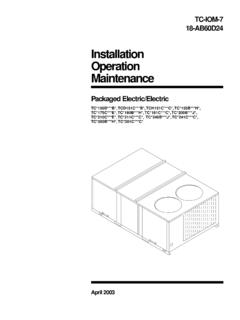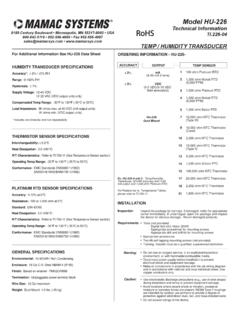Transcription of Evaluation of Computer-Access Solutions for Students With ...
1 The American Journal of Occupational Therapy355 Evaluation of Computer-Access Solutions for Students With Quadriplegic Athetoid Cerebral PalsyKEY WORDS assistive technology Computer-Access treatment human computer interaction (HCI) pediatricsThe concept of human computer interaction (HCI) was first presented by agroup of professionals at the Association for Computing Machinery s SpecialInterest Group on computer Human Interaction Conference in 1992 (Hewett etal., 1996). The concept of HCI was adopted in the present study to define thedomains of computer access for people with disabilities in terms of human factors(level of comfort and satisfaction with the overall operation) and system factors(movement time and accuracy ).There are two gaps in implementing Computer-Access treatment for studentswith multiple and severe physical impairments. From the point of view ofergonomics, such Students are often too physically impaired to activate mechani-cal input devices.
2 Most of these Students also have speech impairments, which fur-ther restrains them from accessing computers or enjoying information technologythrough sound-activated systems. Thus, Students with multiple impairments needdirect-access, nonmechanical or nonhandheld pointer interfaces (dialogue archi-tecture) to use language-free applications (design approaches) for their learning andliteracy needs. In actual practice, these nonmechanical input devices are too expen-sive to buy before they have been successfully tested, and no systems are availablefor free trial or overseas also is a lack of comparative clinical studies to evaluate the performanceof Students with severe disabilities who use nonhandheld pointer interfaces. Hence,this exploratory study aims to compare the quantity output of different computeraccess systems in day-to-day clinical practice. Ultimately, Students with specialneeds will benefit from an Evaluation of the efficacy of Computer-Access Solutions ,because this will affect their academic, communication, and recreational W.
3 K. Man, PDOT, MSc, PhD,is AssociateProfessor, Department of Rehabilitation Sciences, HongKong Polytechnic University, Hung Hom, Kowloon, HongKong; Louisa Wong, PDOT, MSc,is Occupa-tional Therapist, Princess Alexandra Red Cross ResidentialSchool, Kwun Tong, Kowloon, Hong with multiple physical impairments are not capable of using proper pointer devices, thus diminishingtheir opportunities to communicate and learn through computers. This research design used a replicatedsingle-case experimental approach to compare the individual performance of two Students with speechimpairments and quadriplegic athetoid cerebral palsy in using four different Computer-Access Solutions (theCameraMouse, the ASL Head Array mouse emulator, the CrossScanner, and the Quick Glance Eye TrackingSystem). The results demonstrate statistical significance in the correlation of movement time and accuracy tothe level of comfort and satisfaction, which was used to guide the selection of Computer-Access Solutions forclinical interventions.
4 The WinFitts and Assessment of Comfort tests used in this study can be replicated forfurther clinical research into Computer-Access , D. W. K., & Wong, L. (2007). Evaluation of Computer-Access Solutions for Students with quadriplegic athetoidcerebral palsy. American Journal of Occupational Therapy, 61, 355 W. K. Man, Mei-Sheung Louisa WongOccupational therapy strives to innovatively match theresidual abilities of people with severe disabilities with assis-tive technology that is meaningful in their daily activities. Atthe same time, occupational therapists must apply cutting-edge knowledge and skills throughout clinical practice andevaluation. Both therapists and clients must know the rela-tive strengths and limitations of various available nonhand-held pointer interfaces so that the best cost-effective meanscan be determined (DeVries, Deitz, & Anson, 1998).If promising results are obtained from the currentstudy, sufficient grounds will exist to generate a large-scaleclinical study of a standardized test for nonhandheld point-ing interfaces for people with special needs.
5 Thus, the goalof this pilot study was to develop a procedure for evaluatingthe output of Computer-Access systems. The results maysupport the expanded supply of Computer-Access systemsfor daily use by Students with severe disabilities. Supplyingaccess systems is important in terms of their potential toreduce the effects of learning difficulties and to provideaccess to usual computer software without ReviewClinical Study of computer Interface DevicesThe rehabilitation literature reports efforts by researchers todevelop a complete matrix by which people with disabili-ties can be matched with Computer-Access Solutions . In1994, Anson made the first attempt to develop a decisionguideline to match people with disabilities and computeraccess technology. He suggested a group of mouse emula-tor Solutions such as head mouse, eye mouse, or Morsecode input for people with severe disabilities, and he con-cluded that therapists should make their final choice basedon experience and adaptation (Anson, 1994).
6 Hwang(2001) developed a matrix for matching people withupper-limb functional limitations with special accessdevices, according to the existing abilities of the users. Hisresult also suggested a group of systems, such as an eyegazevirtual keyboard or sip-and-puff device. Hwang did not saywhich would be the best solution but did suggest that Fitts Law was a valid model for evaluating Computer-Access solu-tions. Fitts Law is a model of human movement time fromone point to another that Paul Fitt developed in 1954(Shneiderman, 1998). Soukoreff and MacKenzie (1995)then developed Evaluation software to run the Fitts Lawassessment on PCs in DOS mode in 1995. In 1999, theyfurther developed the WinFitts test (a multidirectionalpoint-and-click test that runs on the Windows operatingsystem) for the implementation of ISO 9241-9, which isthe international standard for Ergonomic Requirementsfor Office Work With Visual Display Terminals (VDTs) Part 9 (International Organization for Standardization[ISO], 2000).
7 These studies, however, may not reflect the time limitof matrices the supply of equipment may change fromtime to time and indicate that much work remains todevelop a special or universal design for computer access. Sofar there is no valid test to compare the efficacy of the dif-ferent systems within a group solution. Therefore, a validevaluation test and procedure for evaluating special accesssystems for within-subject comparison among a group ofsuggested systems is important for clinical comparison of related studies on keyboard interfacesis summarized in Table 1. These studies used single-case,repeated-measure designs to compare the typing speed ofhandheld mechanical devices. No standard test was used tomeasure speed, accuracy , and most recent studies concerning visual trackinginterfaces are summarized in Table 2; however, most of theparticipants in these studies were people without disabili-ties, and there was no standard test to compare the effec-tiveness of different interfaces.
8 The typing test is a commontool for speed testing, but the content is not yet standard-ized. Moreover, typing English sentences might not be rep-resentative of the way in which pointer devices will be usedto access computers. Hence, rehabilitation professionals donot have a common platform for within-subject or intra-group comparisons to decide which test or system is thebest choice for people with special (2002) suggested that most evaluations ofinput devices are based on comparative studies and that asingle-case repeated measure may be a guide to investigat-ing the acquisition of skill over multiple sessions of practicewith different systems. This method has the advantage ofallowing those who work directly with people with disabil-ities to quickly obtain more reachable data to continue ordiscontinue the implementation of computer access fortheir clients (Kazdin, 1998).
9 It also hints at the possibilityof running a large-scale group comparative study if the ini-tial findings from a single-case study can support furtherhypothesis 9241-9In 2000, the International Organization for Standardiza-tion (ISO) introduced the complete ISO 9241-9 documentas the standard for requirements for nonkeyboard inputdevices. ISO 9241-9 consists of tests that evaluate the per-formance, comfort, and effort required in the operation ofcommon hand-operated devices for people without disabil-ity (Douglas, Kirkpatrick, & MacKenzie, 1999). The eval-uation has two parts: system factors and human 2007, Volume 61, Number 3 Evaluation of system WinFitts test is a toolfor the Evaluation of movement time and the accuracy ofnonkeyboard pointer interface systems. It is based on Fitts Law and was designed especially for the Windows operatingsystem. It includes a multidirectional pointing task test(Douglas et al.)
10 , 1999; ISO, 2000; MacKenzie, Kauppinen,&Silfverberg, 2001). Evaluation of human questionnaire com-prises 12 questions about the levels of comfort and effortthat are involved in the operation of the system. It measuresresponses on a 7-point interval scale and can be used forwithin-group or between-group comparison (ISO, 2000).To date, four studies have applied the WinFitts test toinvestigate the correlation between human factors and sys-tem factors (see Table 3). Results indicate that all of thetested handheld devices have significant differences inmovement time and error rate. Furthermore, the Assess-ment of Comfort questionnaire (ISO, 2000) demonstratedsignificant correlation between the level of comfort andmovement time and accuracy . Hence, the correlation tableof comfort and system factors reflects the prototype com-puter-access solution for people with special 9241-9 not only provides guidelines for the selec-tion of products but also develops a systematic procedurefor researchers to replicate and compare results from onestudy to the next (MacKenzie et al.


